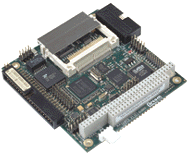Device Profile: HISS Cyber Tracker GPS tracking unit
Oct 31, 2005 — by LinuxDevices Staff — from the LinuxDevices Archive — 17 views![]() Homeland Integrated Security Systems (HISS) has used embedded Linux to build a device aimed at tracking trucks at large shipping centers such as marine ports. The Cyber Tracker is based on an Intel XScale PXA255 processor, Linux, and an IBM J2ME (Java-2 micro-edition) runtime environment.
Homeland Integrated Security Systems (HISS) has used embedded Linux to build a device aimed at tracking trucks at large shipping centers such as marine ports. The Cyber Tracker is based on an Intel XScale PXA255 processor, Linux, and an IBM J2ME (Java-2 micro-edition) runtime environment.
HISS claims the 5 x 5 x 1-inch Cyber Tracker is the first small, rugged tracking device to provide real-time wireless positioning along with triple DES encryption for its transmitted data. The device has been undergoing tests since March, with help from the Maritine Logistics Innovation Center (MLIC), at the Geogia Ports Authority's massive Garden City Terminal, where about 2,500 trucks enter and exit daily.
The Cyber Tracker is designed to be handed out to truck drivers entering large shipping facilities. The driver places the device on the dashboard, where it provides real-time GPS-based vehicle tracking and monitoring using a cellular radio network. The device can be programmed to sound an alarm if it enters a restricted area, or deviates from its specified route. It also provides simultaneous secure push-to-talk voice communications, HISS says.
Cyber Tracker's prototype case
(Click to enlarge)
Cyber Tracker's GPS-based capabilities are said to include:
- Multiple geo-fencing
- Landmarking of buildings and installations
- Bread-crumb trailing
- Speed-limit violations
- Unlimited archiving of historical data
- Stop-time alarms
- Out-of-sight alarms
- Proximity alarms
In addition to tracking trucks, the Cyber Tracker can also be valuable for tracking assets in retail, schools, ports, military, and public safety environments, according to HISS.
What's under the hood?
 The production version of the Cyber Tracker will be based on a customized version of Arcom's Viper PC/104-compatible SBC (single-board computer), pictured on the right. The Viper is a mature product that was touted as the world's first XScale-based PC/104 SBC when it was announced in Sept. of 2002, and Arcom began offering an embedded Linux development kit based on the Viper in July of 2003.
The production version of the Cyber Tracker will be based on a customized version of Arcom's Viper PC/104-compatible SBC (single-board computer), pictured on the right. The Viper is a mature product that was touted as the world's first XScale-based PC/104 SBC when it was announced in Sept. of 2002, and Arcom began offering an embedded Linux development kit based on the Viper in July of 2003.
Unlike the original Arcom Viper SBC, the Cyber Tracker's customized SBC is based on a PXA255 processor clocked at 200MHz, along with soldered-down SDRAM (32MB) and StrataFlash (16MB). The board's SDRAM controller runs by default at 99.5MHz, but can be clocked as low as 50MHz to conserve power, HISS says.
The system also incorporates a GPS receiver and a cellular radio, allowing it to transmit its location wirelessly. A built-in RFID tag in each Cyber Tracker ensures positive identification of the vehicle to which each unit is assigned. The unit also offers optional 802.11 wireless and wired Ethernet networking.
The Cyber Tracker's software will run from a 128MB or 256MB Flash memory “silicon disk,” containing Linux, a J2ME (Java 2 Micro Edition) runtime from IBM, and application software written in Java. The open source Redboot bootloader will be used to launch Linux following system powerup or reset.
Availability
HISS demonstrated Cyber Tracker at the 2005 Maritime Security Expo in New York City, Sept. 20-21, 2005.
This article was originally published on LinuxDevices.com and has been donated to the open source community by QuinStreet Inc. Please visit LinuxToday.com for up-to-date news and articles about Linux and open source.